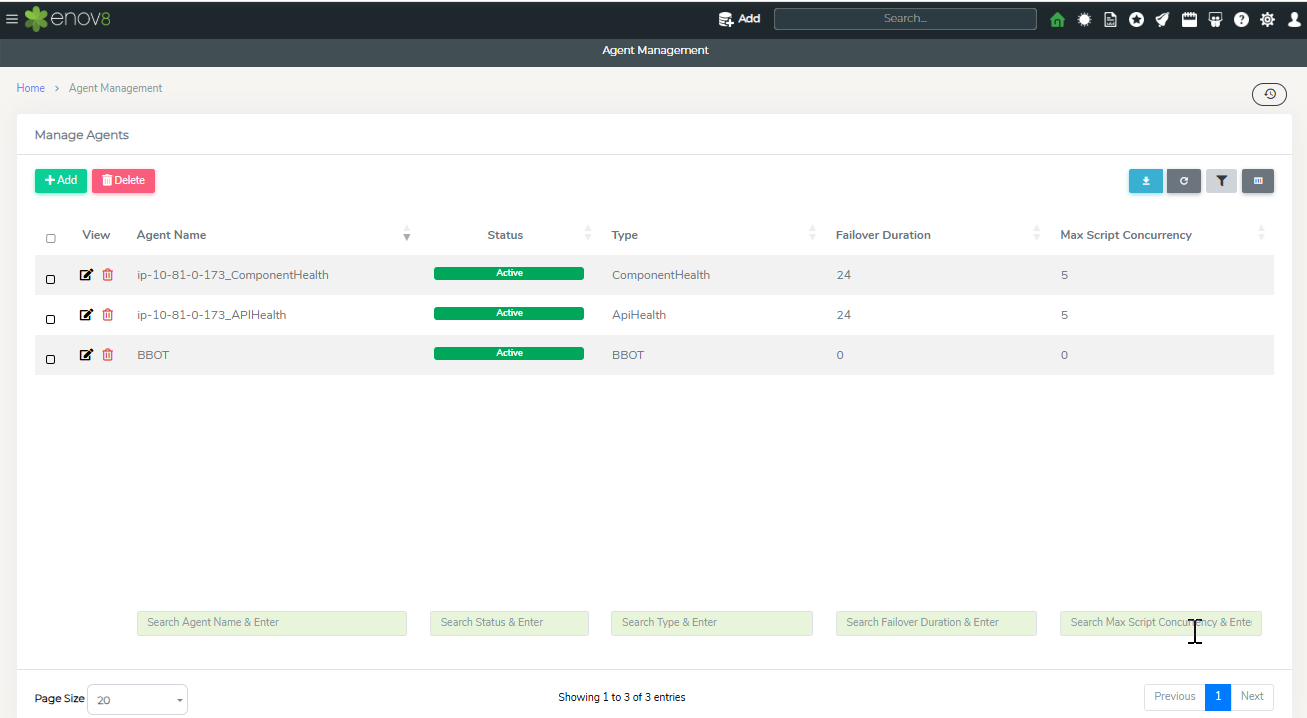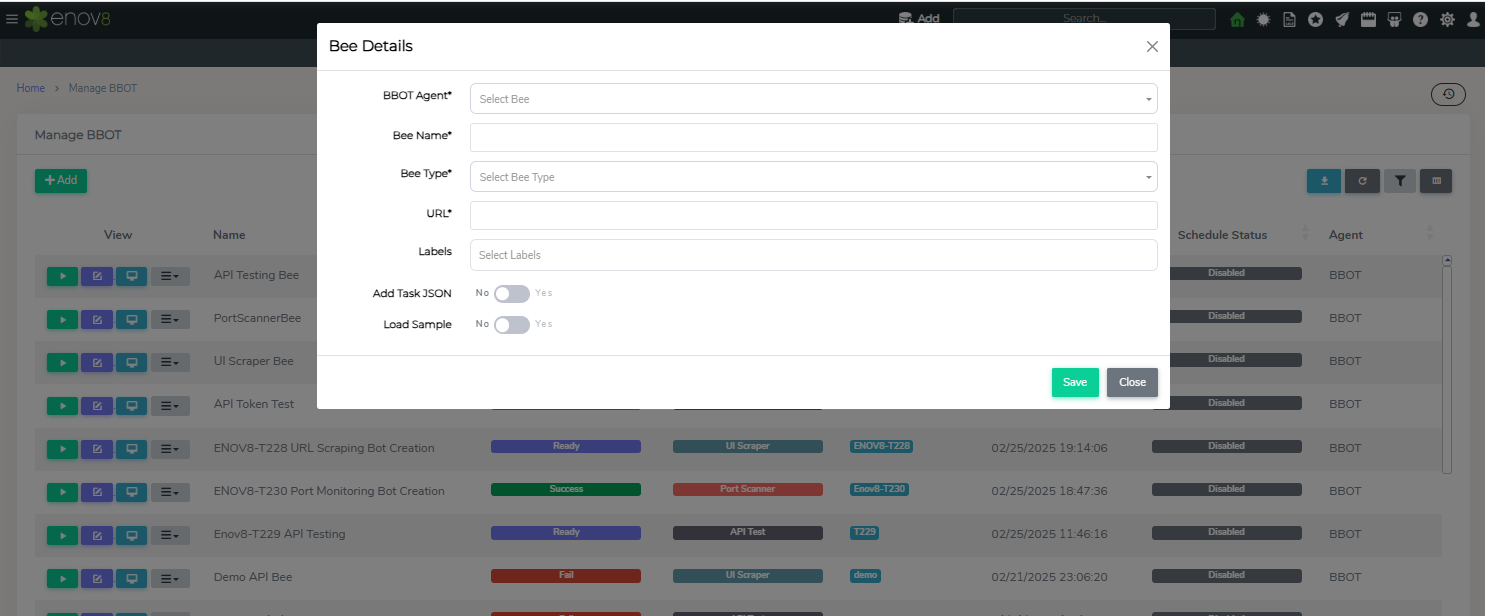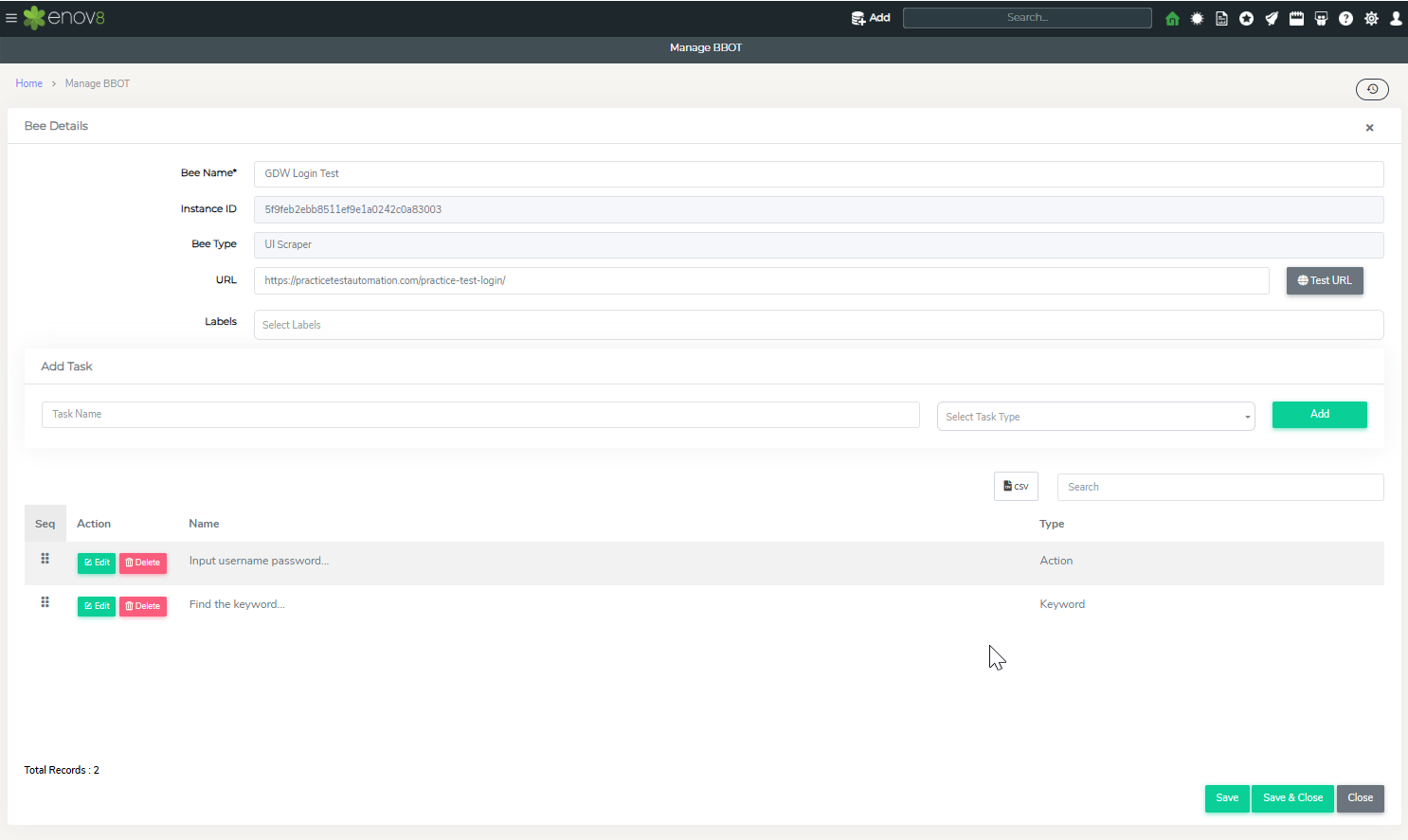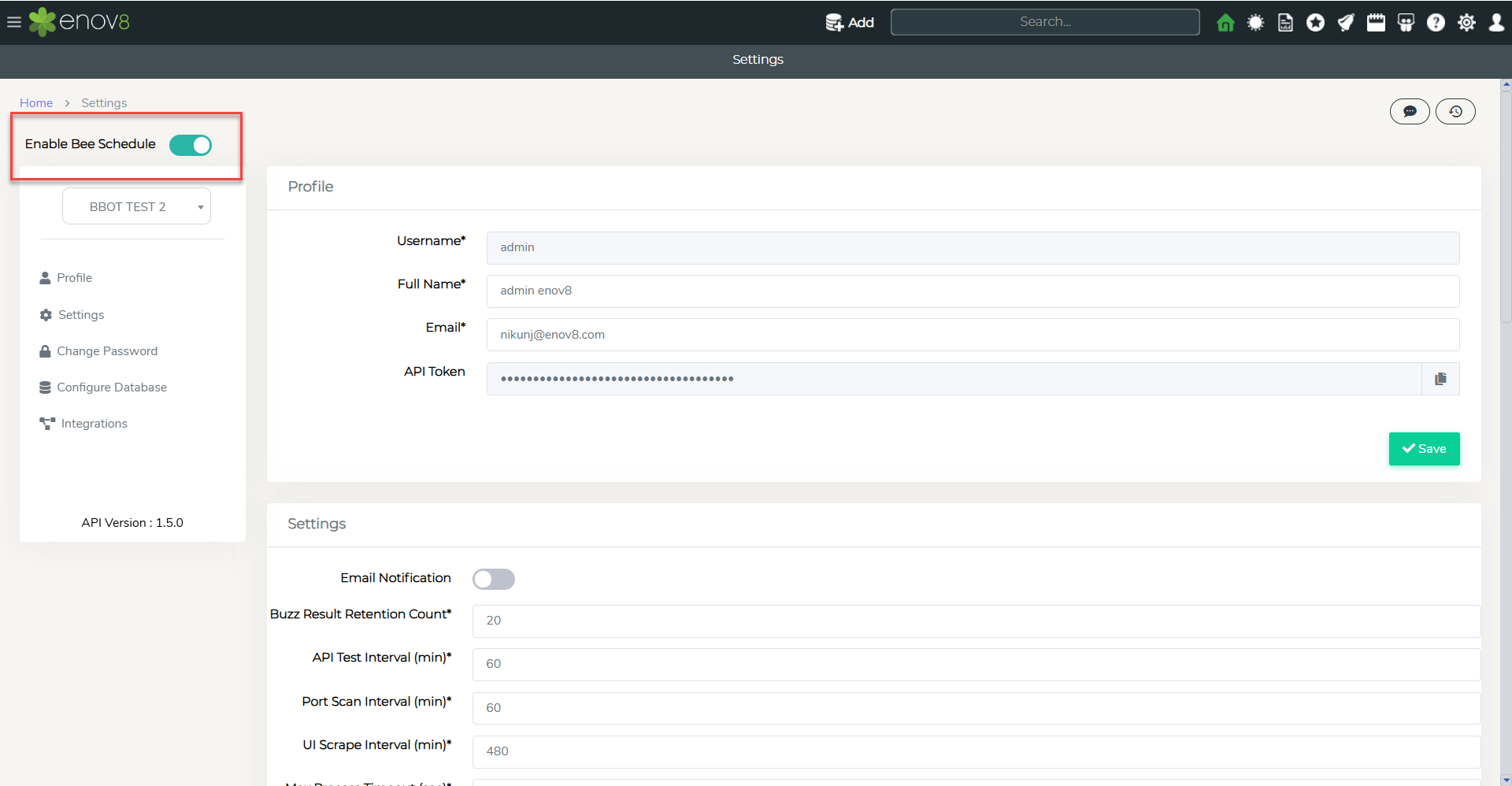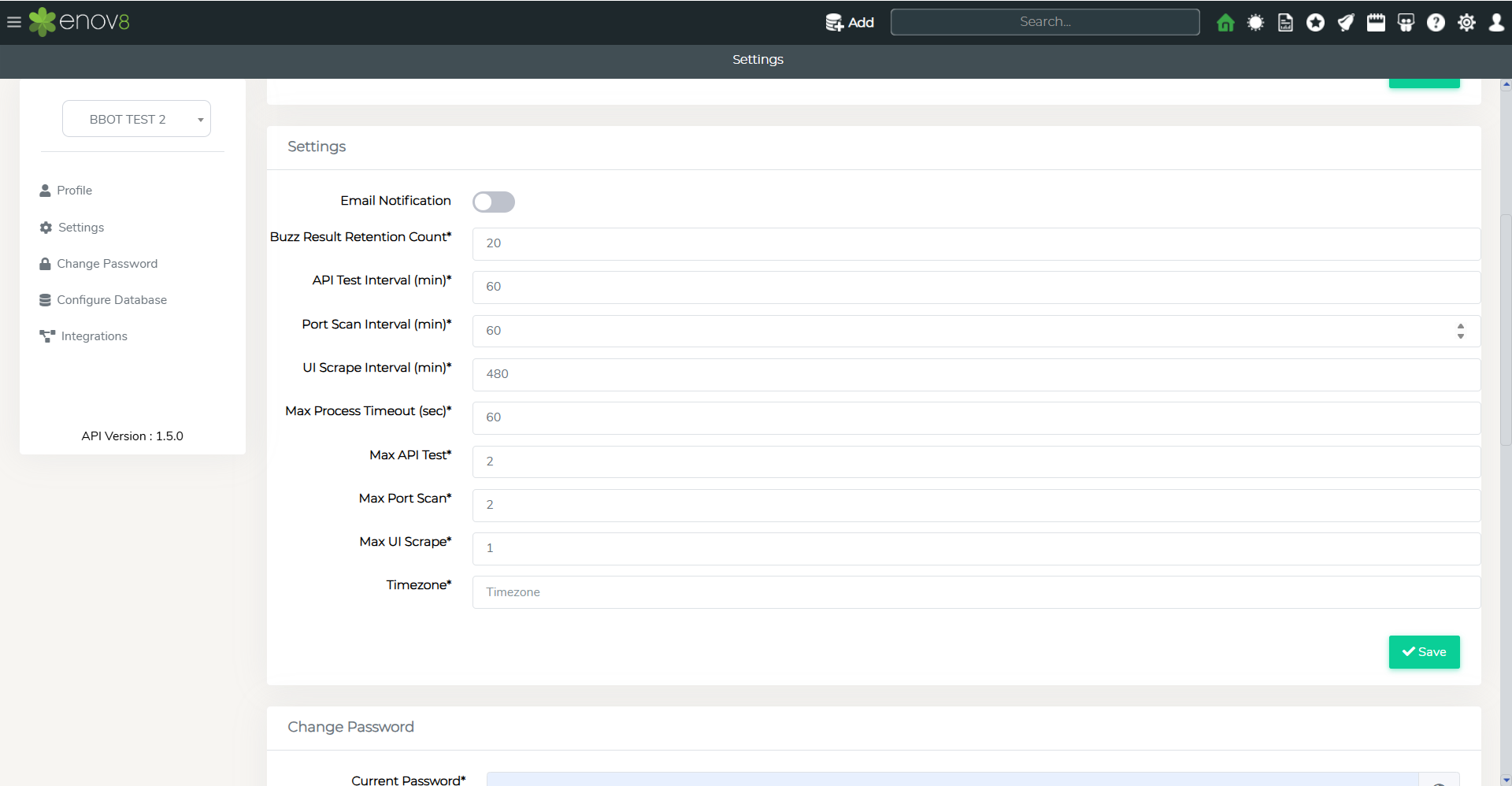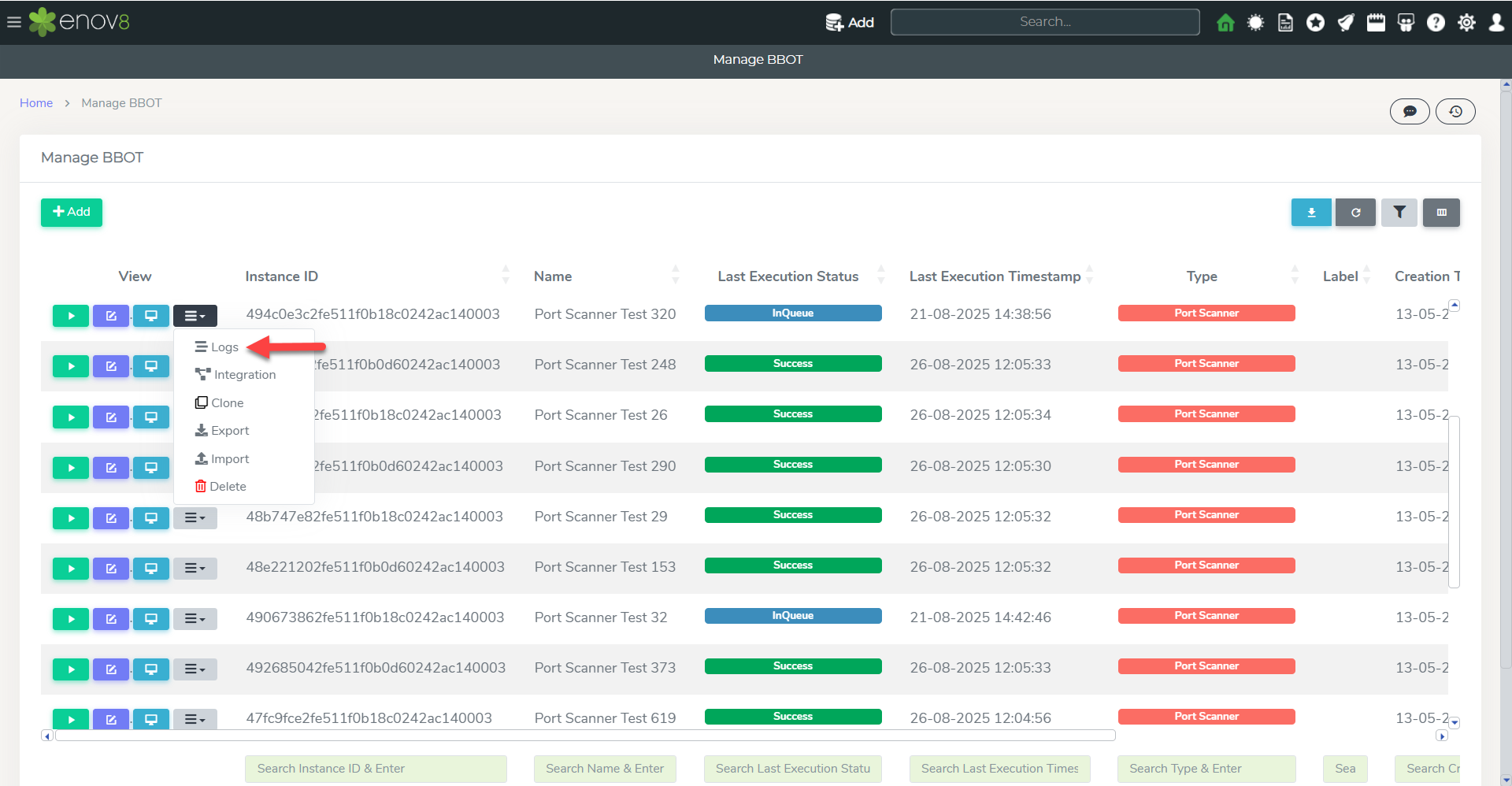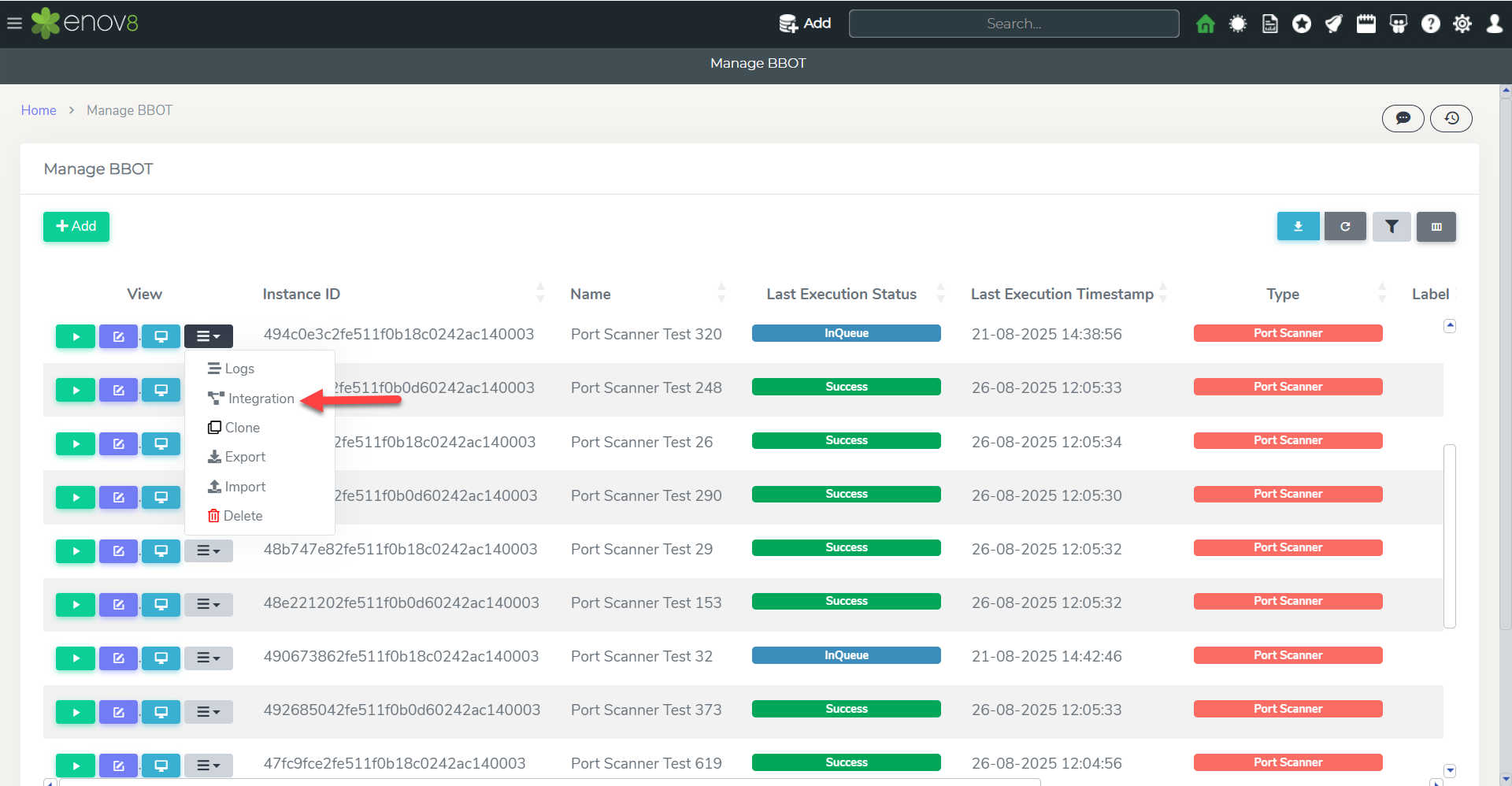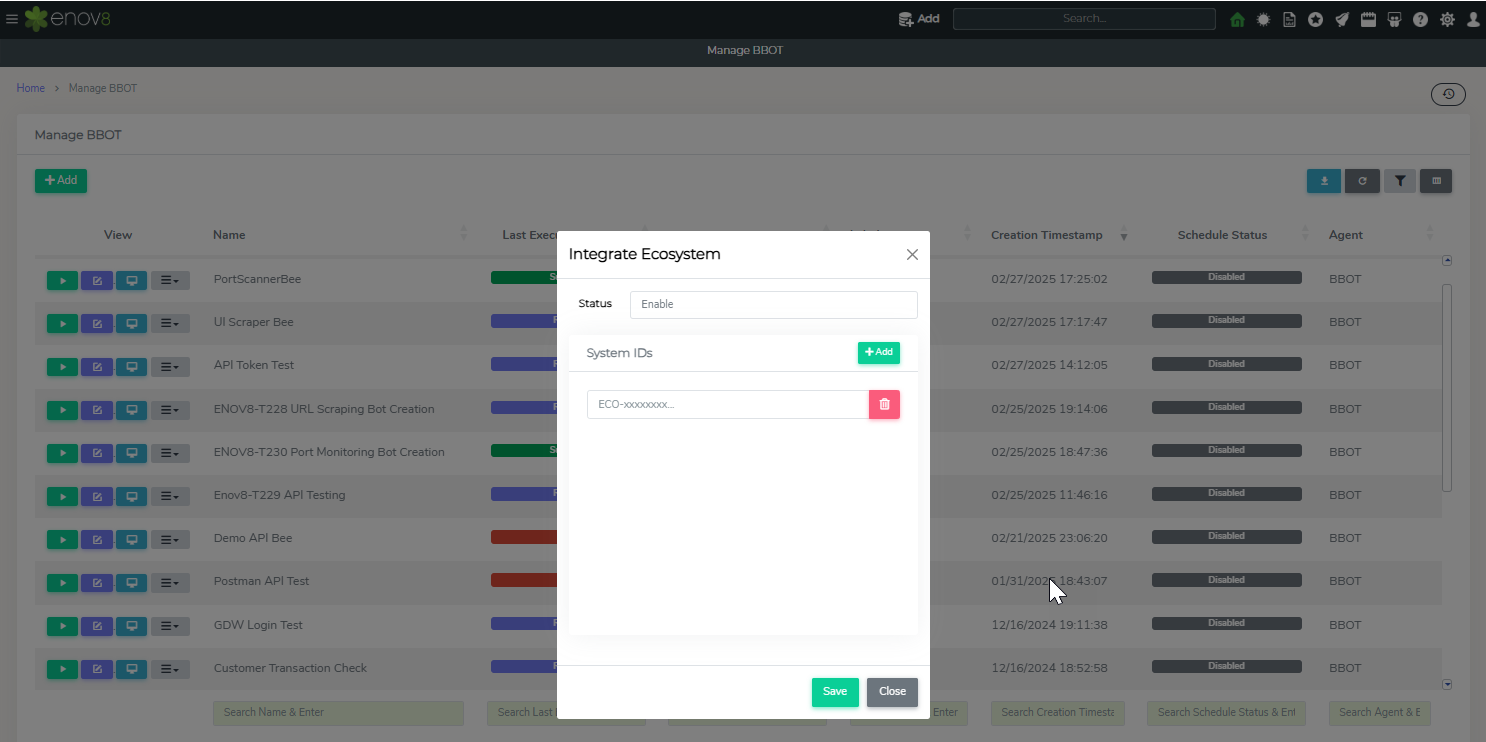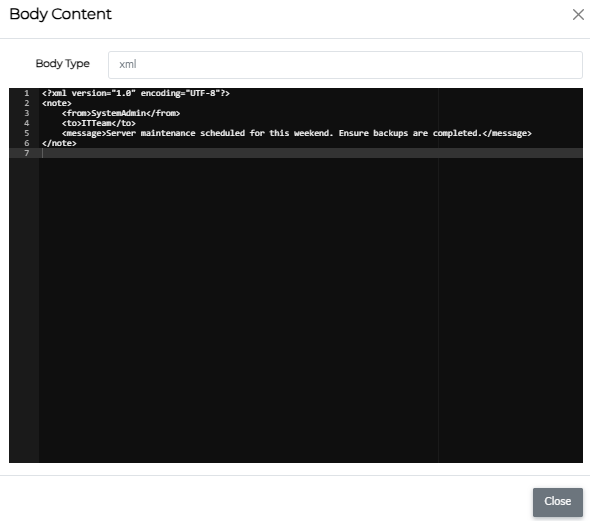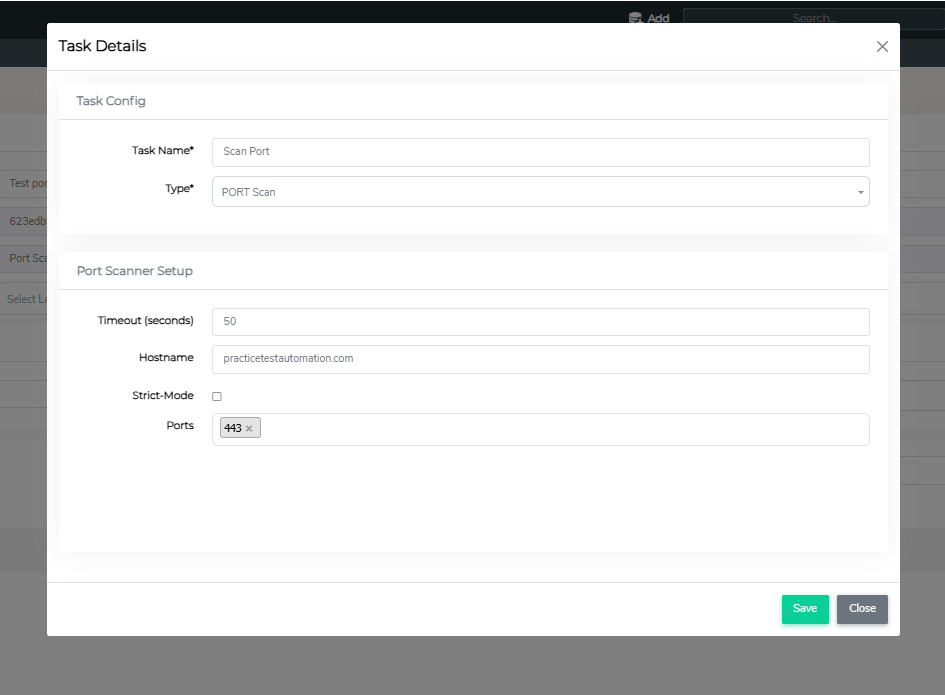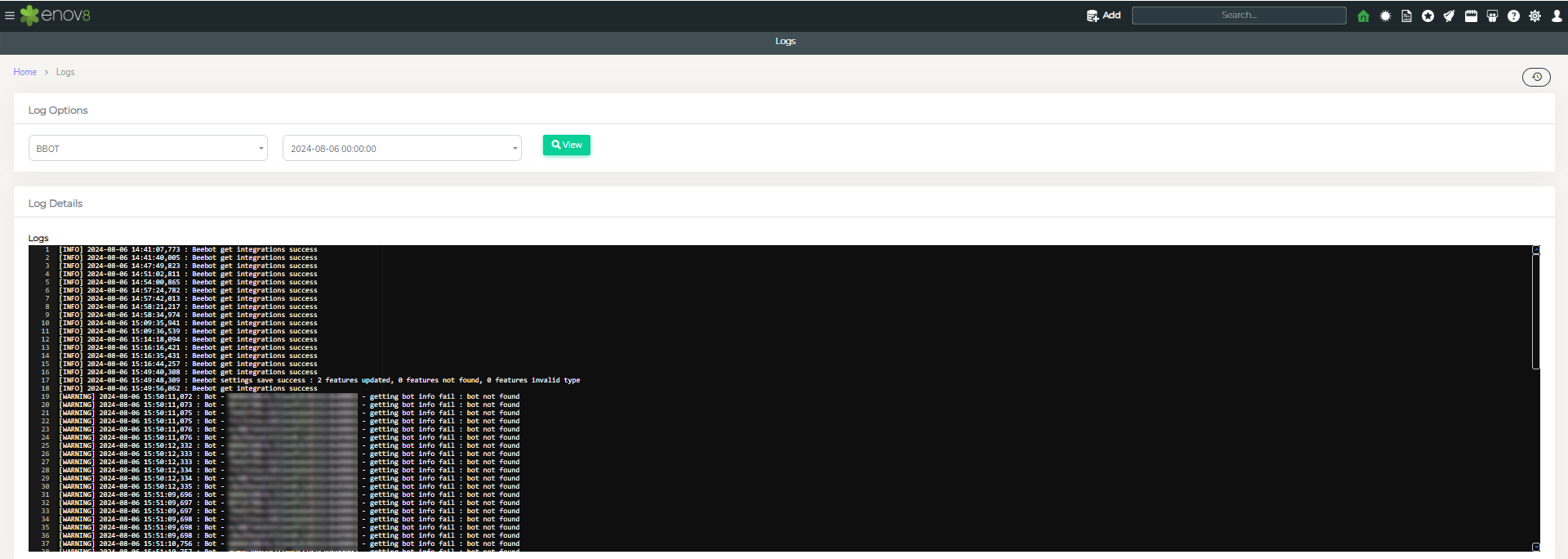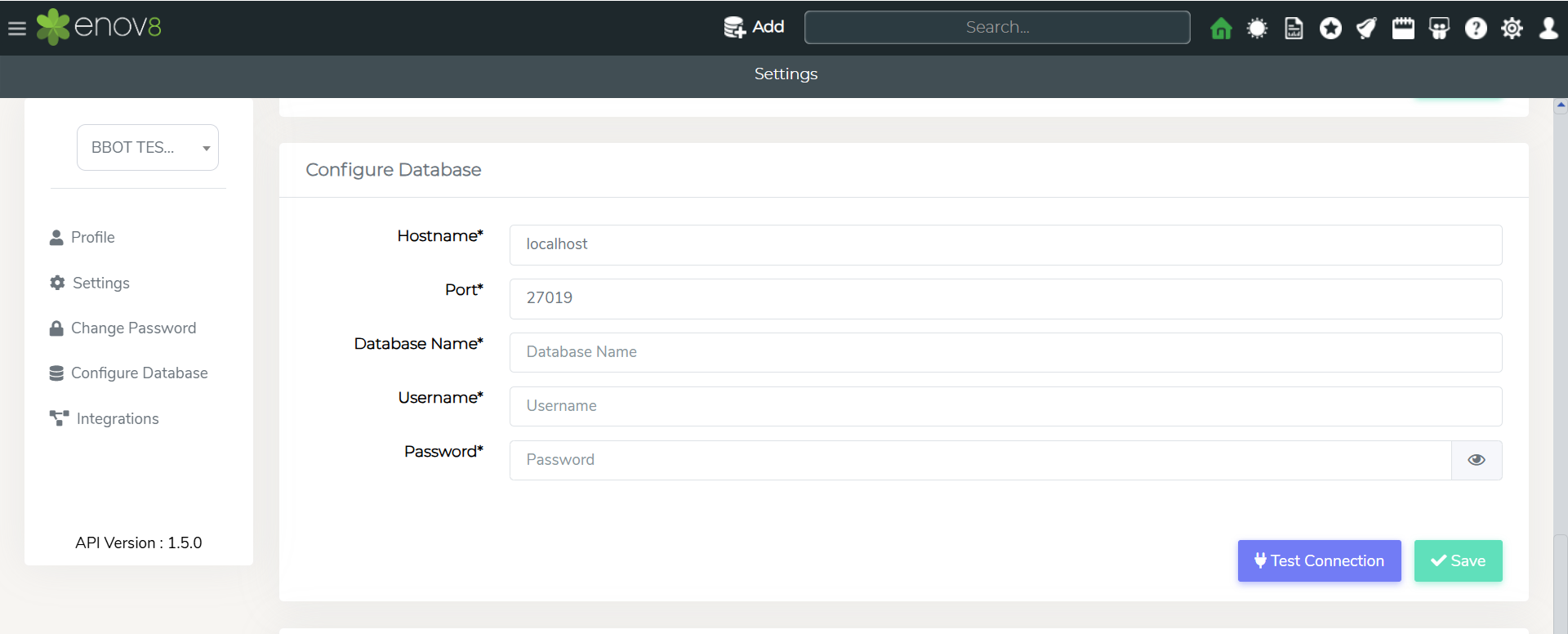Enov8 BBOT User Guide
Configuring BBOT Agent
Once the BBOT Agent is installed, the ecosystem administrator can integrate it into the Enov8 platform by navigating to:
Configuration Management >> System Administration >> Agent Management
To add the agent, click Add. A modal popup form will appear. In this form, select the type as BBOT and fill in the details as described below:
| Field Name | Description |
|---|---|
| Agent Name | Name of the BBOT Agent Server or a user-friendly name for identification. |
| Type | BBOT |
| BBOT URL | The URL of the BBOT Backend provided during installation. For example, https://demo.company.com/beebackend/. |
| Status | Set to Active. |
| Username | Username provided during installation. |
| Password | Password provided during installation. |
Manage BBOT
Once the BBOT Agent has been added, all the bees can be managed in the ecosystem via the Manage BBOT section. This can be accessed by navigating to:
Orchestration Management >> BBOT Monitoring >> Manage BBOT
This section provides users with a comprehensive overview of all the bee instances from all configured BBOT Agents, including their last execution status and creation timestamp.
Add New Bee
To enable the creation of a bee, users can utilize the functionality of the system by selecting the "ADD" button positioned at the top of the table. By inputting the relevant information such as the bee's name, type and optionally assigning labels, users can successfully generate a new bee within the system.
Load Sample & Add Task JSON feature will be available as part of upcoming release
In addition to the standard fields, the form provides two key options:
- LOAD SAMPLE: Allows users to add a sample bee, helping them understand the required tasks and necessary settings.
- Add Task JSON: Enables users to upload tasks directly as a JSON file, streamlining the configuration process.
Once the user clicks on the Save button, they will be redirected to the configuration interface of the bee. This interface can also be accessed by clicking on the edit icon in the manage bee listing section.
Tasks
In the task section of the edit configuration module, users are granted the capability to meticulously configure the sequential steps that the bee instance will undertake to successfully locate the specified keyword, which in this case is "health check." This entails defining the precise actions, procedures, and algorithms that the bee will employ during its execution to fulfill the objective of identifying the required keyword within the designated context.
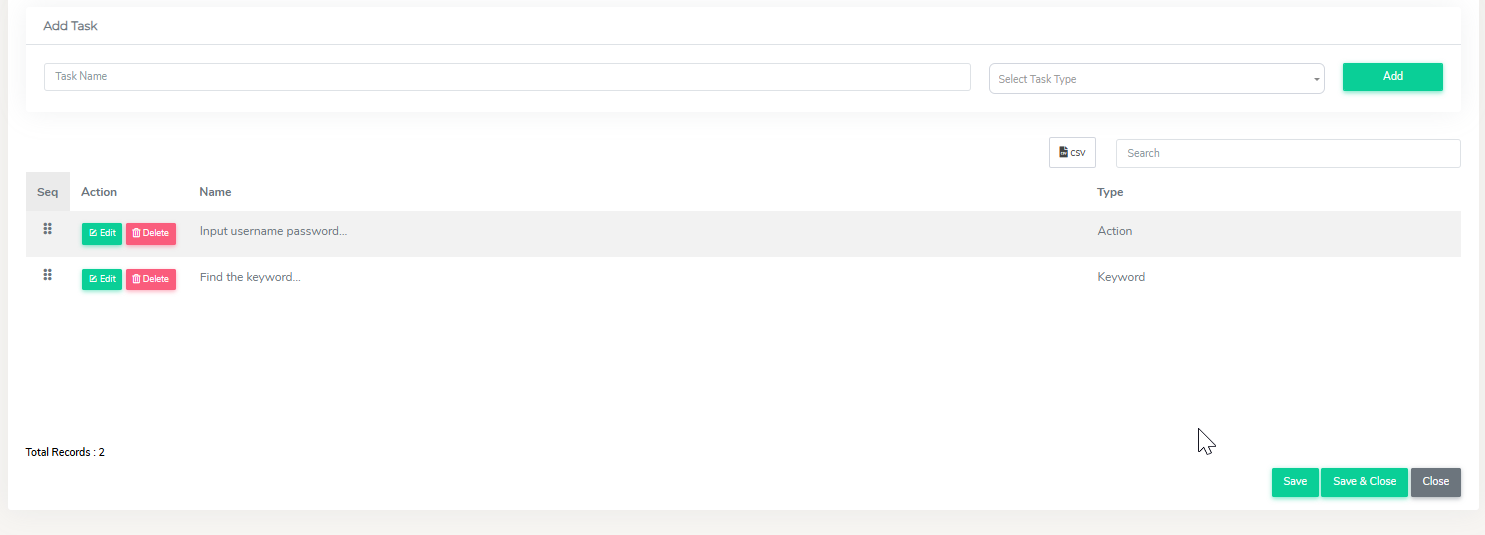
Schedule
In BBOT Monitoring, scheduling is configured globally through the Settings screen. Instead of defining per-bee schedules, administrators now control all monitoring tasks using a single global toggle and interval fields.
Global Control
- Enable for All → Activates all BBOT tasks (API Test, Port Scan, UI Scrape) according to their configured intervals.
- Disable for All → Deactivates all BBOT tasks with one action.
Interval Settings
You can define how frequently each task runs using numeric interval values:
| Setting | Description |
|---|---|
| API Test Interval (min) | Frequency (in minutes) for API Test execution. |
| Port Scan Interval (min) | Frequency (in minutes) for Port Scan execution. |
| UI Scrape Interval (min) | Frequency (in minutes) for UI Scrape execution. |
| Max Process Timeout (sec) | Maximum execution time allowed for any task before termination. |
| Max API Test | Maximum number of concurrent API Test tasks allowed. |
| Max Port Scan | Maximum number of concurrent Port Scan tasks allowed. |
| Max UI Scrape | Maximum number of concurrent UI Scrape tasks allowed. |
| Timezone | Timezone applied to all scheduling and reporting. |
Execution Results
The result section contains all the outputs from the Bee's buzz (run). Each run has their run timeframe and the status of each run. Users can see an advanced view of the output by clicking on "Details" button on the specific. The advanced view empowers users with a high level of visibility and control, facilitating effective monitoring and management of the bee's tasks and their corresponding results.
In order to view the execution results for the individual bee, simply click on the result icon in the listing.
Bee Logs
Each bee will contain their own sets of logs which includes their run period and results of each action. To view the logs of an individual bee, simply click on the menu options in front of the bee listing and click on Logs.
This will open up a listing of all the available logs for the bee.
To view the log, simply click the Log button on the left hand side.
Integration
Refer to integration section in settings prior to this setup.
This section is used to integrate the bee with ecosystem CMDB item. In order to link the bee with ecosystem CMDB CI, simply click on the menu options in front of the bee listing and click on Integration.
To integrate, simply change the status to Enable and provide the Environment Instances/System Components "System ID" by clicking "Add" button. Once the integration is in place, the bee will automatically change the status of Environment Instance or System Component based on the execution success or failure.
Bee Types
UI Scrape Bee
UI Scrape Essentials specializes in extracting HTML content and conducting in-depth analyses to identify both fundamental and advanced keyword search patterns.
Task Creation
To create a task, users can click on "ADD TASK" button on the top right, and be prompted to input name and type of action.

After creating a task, you can modify the task steps by clicking on the "Edit" button.

Task Setup
In the task edit/modify section, users can select between two different types of tasks:
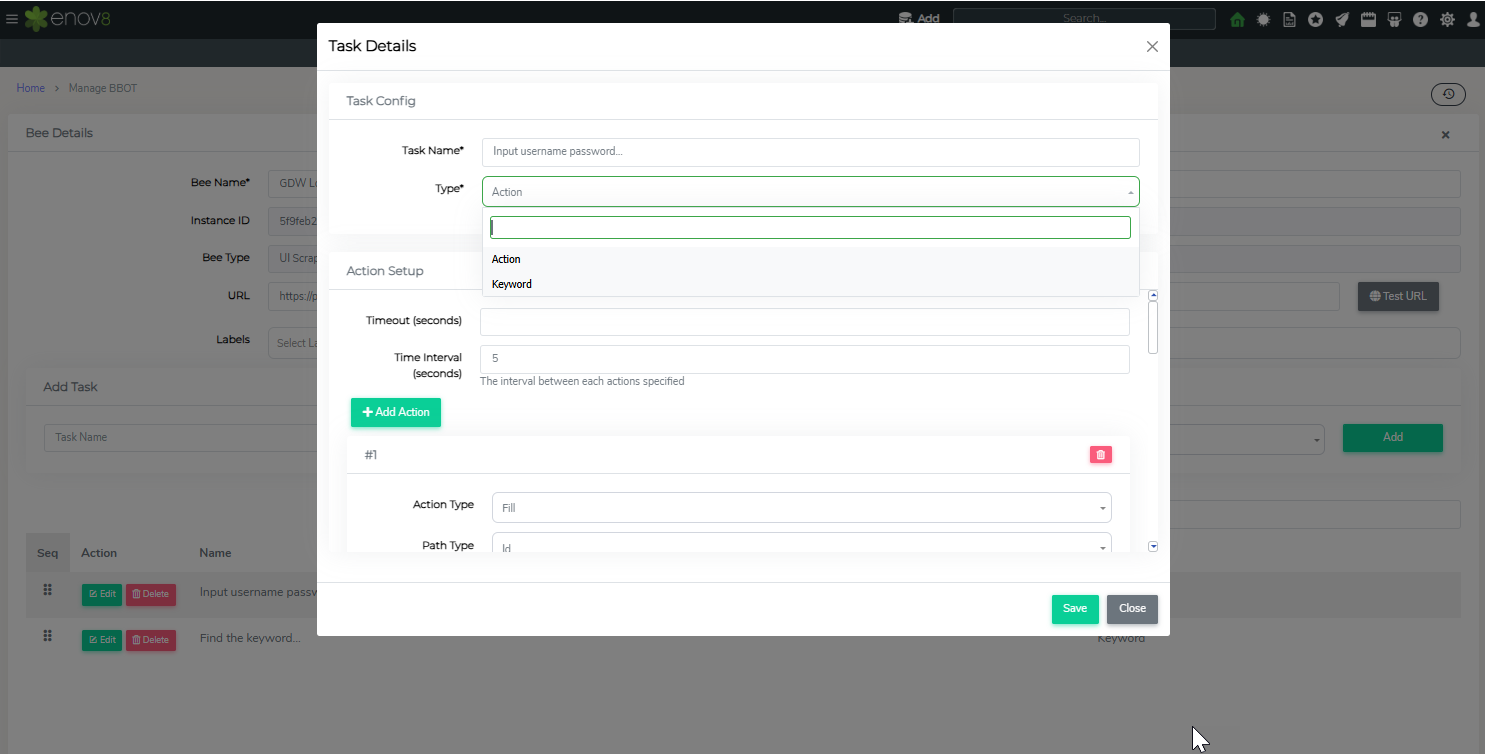
Action Task
Within this type of task, users can create action that can enable tool to fill and click on specific HTML elements. User can also enter an iFrame or exit an iFrame
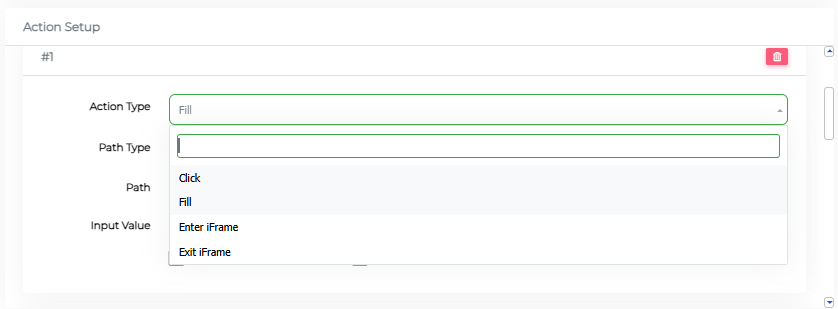
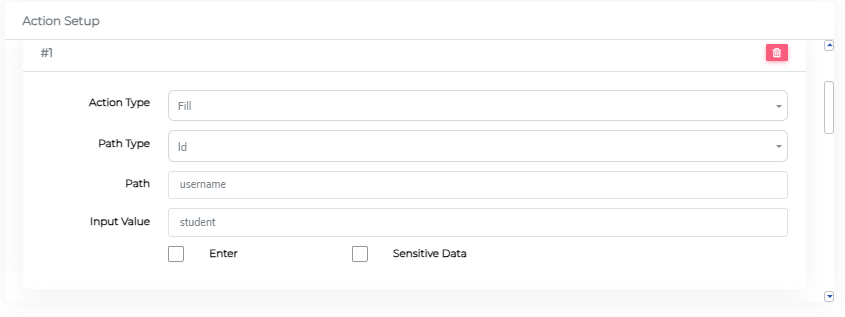
Fill Input Action: Users can select the path type and path to give the BBIT tool to input a text field.
Supported Path Types:
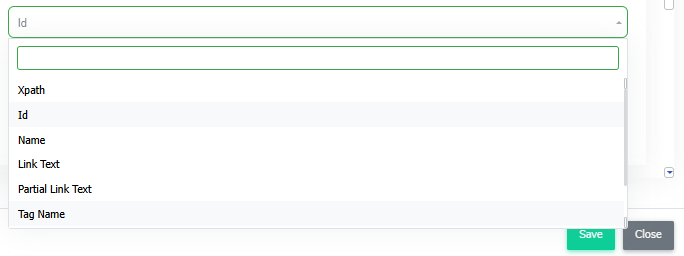
When dealing with sensitive data, users can opt to sensitive data where the data will be stored in a hashed format.
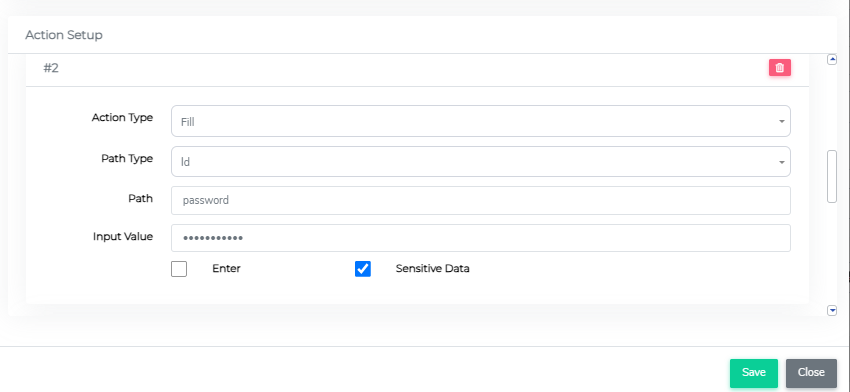
Additionally, users can decide to "ENTER" to submit the form to allow for quick keyword find.
Click Input Action: Like the fill action type, a click action type requires the path type and path value for BBOT to click on the specified HTML element.
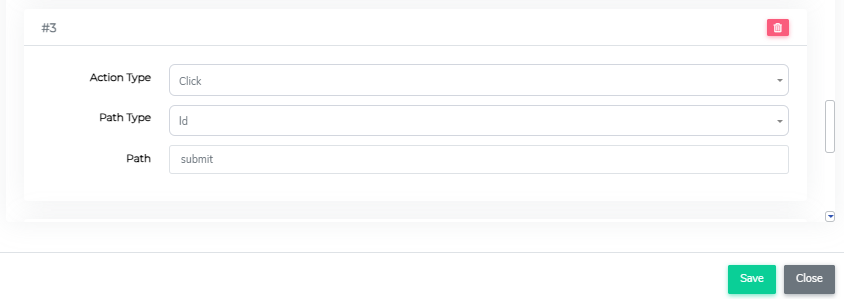
Enter iFrame Action: Similar to the above types, enter iFrame type allows BBOT to enter an iFrame and proceed with the operations.

Exit iFrame Action: Exit IFrame type immediately returns the BBOT back to parent html.

Keyword Task
Users can define the keywords to find by simply clicking the add button and add as many keywords as needed.
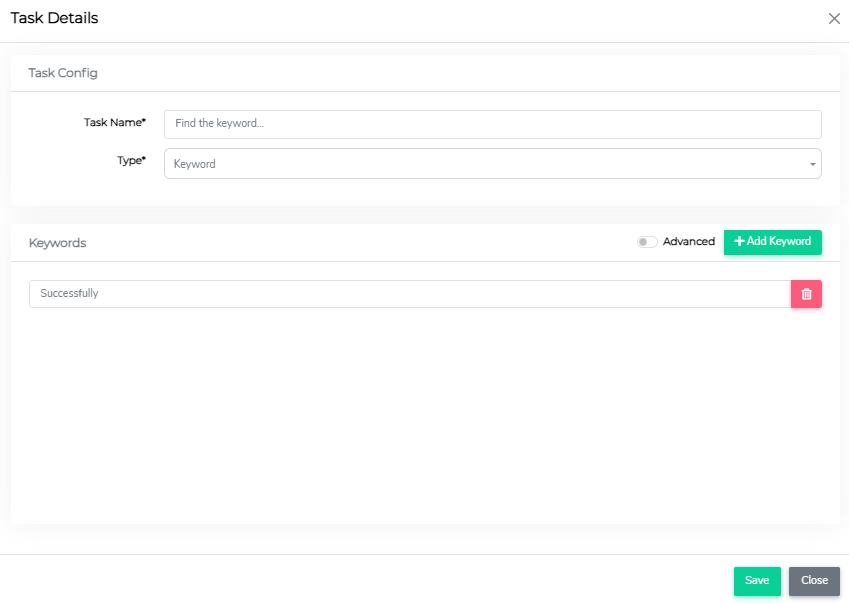
Advanced keyword setup offers a deep search capability to HTML contents. Simple tick "Advanced" check box and click "Add Keyword" button. Then simply click on "EDIT" icon button to configure the advanced keywords. Like basic, users can create as many keywords as needed.

Then a prompt will open up requesting users to input various components of the HTML content to find the exact word.
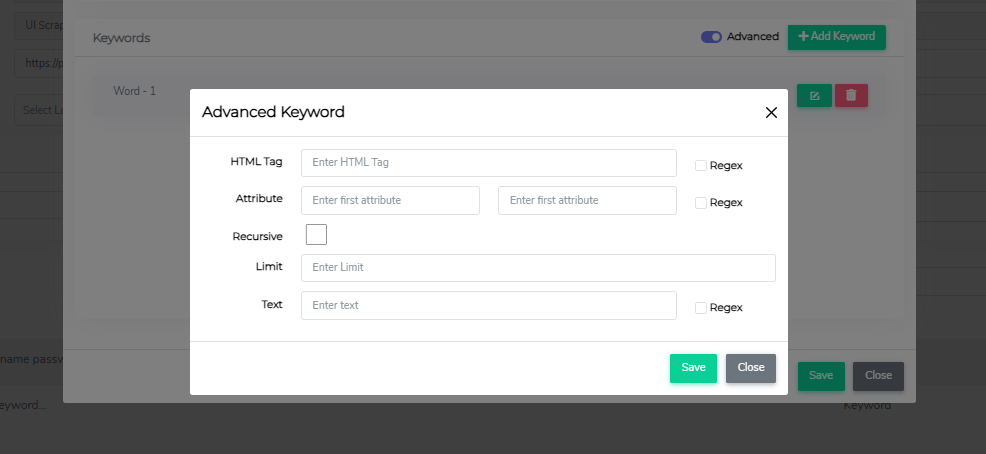
The properties are:
| Property | Description |
|---|---|
| HTML Tag | An HTML tag is a set of characters used to define the structure and formatting of elements within an HTML document, such as <p> for paragraphs or <img> for images. |
| Attribute | An attribute in HTML provides additional information or modifies the behavior of HTML elements. For example, the href attribute in an <a> tag specifies the URL of the hyperlink. |
| Recursive | In the context of HTML, recursive refers to the ability of an HTML element to contain other elements of the same type within itself. For instance, an <ul> (unordered list) element can have multiple <li> (list item) elements nested inside it. |
| Limit | The term "limit" in HTML refers to various restrictions or bounds that apply to different aspects. For example, there may be a character limit for the content of an input field or a limit on the number of elements allowed within a certain container. |
| Text | In HTML, text refers to the content or written information within an HTML element. It can include plain text, headings, paragraphs, links, and more, which are all essential components of the textual content displayed on a web page. |
Each properties have regex support to easily identify keywords.
API Test
API Test Suite primarily focuses on evaluating APIs by thoroughly testing their GET, POST, PUT, DELETE, and PATCH functionalities. It meticulously verifies expected keywords, headers, and responses to ensure the integrity and reliability of the API.
Task Setup
To create a task, just click on "ADD TASK" and you will be prompted to create a task. For API Test, there is only one type of task "API Request" which handles all types of HTTP requests.
Once the task has been added as part of previpus step, proceed to modify the task by clicking on "Edit".
To add your endpoint, you can input in the API URL text field:
Within URL, you can use stored variable with "**{ storedvariable }**".
Here the stored variable can be any variable stored in the prior tasks.
Within API Request setup, it is categorised into two section - Request and Result.
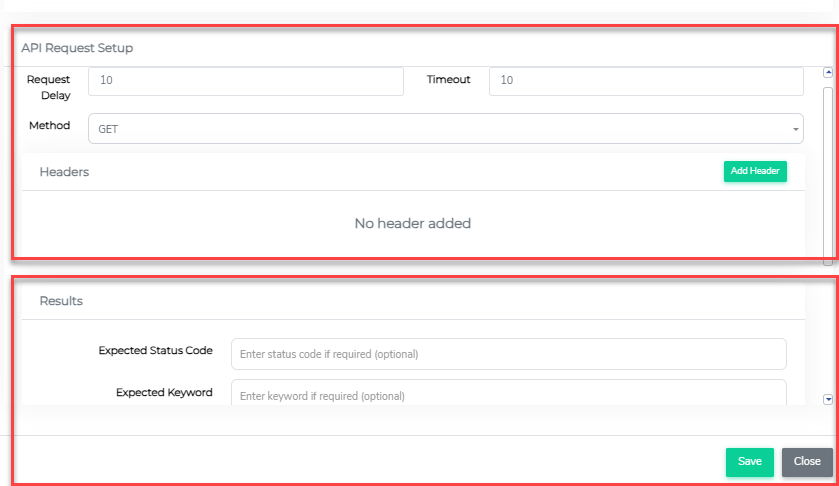
In request:
Request Delay - A delay to prevent the next task from activating immediately upon this request. Default: 0 seconds. Method - GET, POST, PUT, DELETE, PATCH. Timeout - To limit the run time of the request. Default: 5 seconds. Headers - Users can add headers by clicking on "ADD" and input a key and value.
Users can also used stored variables from previous requests by ticking the enabling use stored. This will allow users to select a drop-down menu of the available stored variables.
Stored variables must be set in the prior tasks for this to work.
After the header is created, it gets added below the header title. Here you can continue to configure the value of header and/or delete the header.

For methods (except for "GET"), user have the option to add body to their request. Simply click "EDIT" and you can add a JSON, XML and Text body to your request.
To use stored variable in body, make sure to input the value in as "storedvariable ". For example, if the token value is stored as "token" when setting up stored variable, then users can use the variable in the following task's body by using "__token__".
In result
Here you can up expected status codes, expected keywords and expected headers. Each of them supports multiple values. However: Expected Status Code -- If one of them is present the task will pass. Expected Keywords & Expected Headers -- expects all the values to be found for the task to be found.
To add a stored variable, users can click on "ADD" and be prompted to create a variable.
Here the key ("Variable Store *") would be the name the variable would be stored at and the value would be of what to save from the response from the request. For example, if the return looked something like this.

To store token, the value would be profile.token.
Port Scanner
Port Scanner searches through hostname and port list to find out if the ports are open at the scanned time.
Task Setup
To create a task, just click on "ADD TASK" and you will be prompted to create a task. For Port Scanner, there is only one type of task "Port Scan".
Once the task is added, proceed to modify the task by clicking on "Edit".
To setup port scanner, user must specify timeout, hostname and ports. Optionally, they can enable/disable strict mode. Enabling strict mode will require all the ports in the port scan to be successful for the task to pass.
Logs
Similar to the individual bee's log records, this encompasses comprehensive global information pertaining to accessed pages, scheduled, and executed bees, as well as other backend server activities. To view logs, select the BBOT Agent for which the logs has to be viewed and then select the log file.
Settings
The setting section provides user access to manage setting of all the bbot agents that has been configured. To change settings, simply select the BBOT Agent from th left option bar.
Options have five sections to explore:
-
Profile
-
Settings
-
Change Password
-
Configure Database
-
Integrations
Profile
In this section, users can configure their username, full name, email address and API Token to use REST API's for the selected BBOT Agent.
Settings
This section allow the adminstrator to configure the following options
-
Email Notifications - Enable notifications via email.
-
Buzz Result Retention Count - The number of outputs to store for each bee.
-
API Test Interval (min) - Frequency (in minutes) at which API tests are executed
-
Port Scan Interval (min) - Frequency (in minutes) at which port scans are performed
-
UI Scrape Interval (min) - Frequency (in minutes) at which UI scraping tasks are run
-
Max Process Timeout (sec) - Maximum allowed execution time for any process
-
Max API Test - Maximum number of API tests that can run in parallel
-
Max Port Scan - Maximum number of port scans that can run in parallel
-
Max UI Scrape - Maximum number of UI scraping tasks that can run in parallel
-
Timezone - The timezone used for scheduling and timestamps
Change Password
This section allows the user to change the current password of the BBOT Agent admin user.
Configure Database
This section allows configuration of the BBOT database connection.
- Hostname – Database host server.
- Port – Database server port.
- Database Name – Name of the database used by BBOT.
- Username – Database username.
- Password – Database password.
Options available:
- Test Connection – Verify connectivity with the database.
- Save – Store the configuration.
Integrations
This sections allows the admin to setup the integration with Enov8 platform. Please contact your ecosystem administrator to get the REST API Details as required in the below screenshot.
